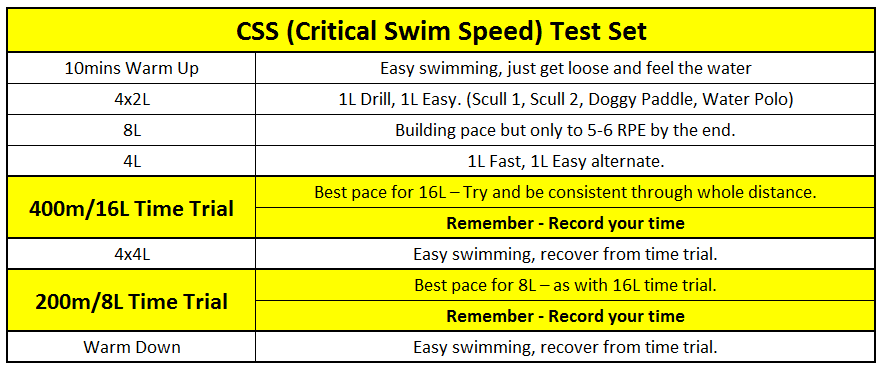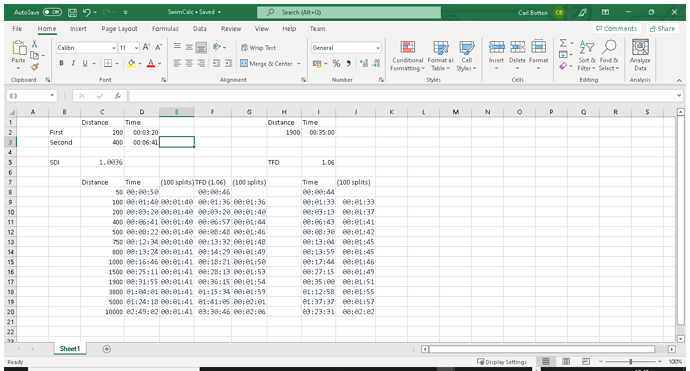Good work, you know a strong CSS test you up for some tough sessions down the road though right ![]() .
.
which protocol did they use for testing?
It was warm up then drills. 5 mins recovery, 100m build, short rest then the 400m. 5 mins recovery, 100m build and then the 200m.
What were your 400m & 200m times. I’m curious as my CSS is 1:40 but you can achieve the same CSS pace with very different swim times. Mine were 6:31 & 3:11.
6.41 & 3.20
It’s bizarre that your times are so much quicker yet CSS only 1 second faster.
Yeah, that was the reason for my question as you do get that with CSS. There’s basically no difference between your 400 & 200m pace whereas I do drop a bit over 400m. Swim Smooth suggest a 4% drop-off is normal in their “becoming a diesel” spiel.
It’s because it is flawed as a method to find your second threshold ![]()
your club tests, is the warm up the same every time you test, the drills identical? Why build into it with a 100. Was it individual, clean water or in a pace line on feet, same order every time if in a pace line, were they at the same pace as before or towing you at a faster pace? So many variables to be meaningful meaning testing in a group swim is little more than an arbitrary exercise. When I test the juniors we do two to a lane start opposite ends and the others watch. Even then its not ideal as it can be affected by the Warm Up, length between swims, time sitting poolside. We find ways to try to make it more consistent but its never perfect. It’s why I just use my “coaches eye” to “test” , you can generally see with similar sessions over time
The CSS calculation is (400 - 200) / 2, so it is a measure of drop off rather than raw pace. The theory being that @JaRok2300 is more of a sprinter than @Jgav so needs to do css reps slower to build up endurance.
I was 2 to a lane so I was swimming into clean water. Not done a CSS with the club before so can’t comment on how replicable it is.
I’m not sure on the reason for doing the 100m build, coach said to do it with a 30 second pause before each test swim.
This is the set we use, sounds pretty similar to yours, and we do the same one every time we do a test.
I generally swim on the front of my lane but we often have 4/5 in a lane so drafting is an issue for many people’s results. Despite telling them to leave a big gap, too many still see it as a willy waving exercise to get the lowest number possible and sit on the feet of someone faster.
And yet my CSS pace is slightly quicker from the test.
I think the argument would be that my CSS pace is slower than either my 400 & 200m swims so it would have me training at a slower pace than I was actually swimming at (for stamina) whereas Jgav’s CSS pace is pretty much the same as the speed he was swimming at so he is swimming faster, relatively speaking, to build more top end. Ultimately supporting your point.
I used to end up in a lane with someone who swam both the 400 and 200 quicker than me, but we had more or less the same css. Sure enough, he would lead the first half of the session and I would be hanging on, then by the 2nd half I would take the lead and he would be trying to keep up. Worked well until I stopped swimming for 2 years…
CSS is a test to estimate your threshold pace. It is massively flawed as a protocol though as 1) everyone does it slightly different 2) everyone’s times are different so could be using entirely different energy systems , ie a 200 may be VO2 max or even slower for a triathlete but an elite or good club swimmer will be using largely their anaerobic energy system, hence why originally a 50 was used. It massively over estimates most peoples 2nd threshold pace, how many of you can swim 1500m at your CSS pace? Testing is also flawed due to inconsistencies with turns, underwater and breakouts in most AOS. Its basically giving you a figure to gauge improvement and little more, you can do this by doing TT’s in various distances over time. Much like the various FTP tests out there, many are literally giving you an ego boost rather than accurately giving you the point of the second threshold.
For setting lanes i typically use 10 x 100 tests on new squads, and would with remote athletes just to give a turnaround time. its not a test for setting the 2nd threshold but it helps split lanes evenly and give a turnaround for aerobic or VO2 max work. Threshold testing in itself is hard to get accurate without invasive lactate testing which is very difficult to do well in a poolside environment. I have been lucky enough to see a study on another protocol but its not really something an average swimmer could use without massive breakdown in stroke mechanics making the results harder to interpret. A traditional “pace curve” works well though, i shared details of calculations on here with SDI and TFD calculations before so you can see if you are a diesel or sprinter and areas for improvement.
Don’t disagree with any of that and to confirm your point, there’s not a cat in hell’s chance I could do 1500m at 1:40 pace.
I use it as a gauge of improvement (or vice versa) as we 've been doing it for a few years now so I have historical data which I’d lose if changing to a new protocol.
n = 1 when I did it, closer to my 1k pace than 1500m . Talking to others have suggested similar results.
it would be good to see a flat out 50 time as well alongside one of those. Id like to see 400 and 200 times done individually (not in the same session)
Agreed, but…
For me it’s a way to get a benchmark for me. I didn’t need one to know that I’ve improved as previously I would have flailed and exhausted myself to a 1.55 100m and now I have done sets of 100s under 1.50 off 2.00
In a month or two’s time, we’ll probably do another one and I’d be happy with the same result if I can get close to holding that pace over longer distances e.g. up to 1000m.
My season / race target is to do 1900m in 35 mins.
I only really time individual swims when we do a CSS test. The rest of the time I leave my watch running for an hour just as a record of distance/time of the session. I would guess about 40s for a flat out 50.
that’s showing current SDI (1.00, so would probably need more data to be meaningful), what 1.06 would give and what sort of times would hit 35min / 1900 with a standard 1.06. but you should be easily able to hit 35!
Yeah I tried doing the CSS thing but couldn’t really get my head round it and it was tricky to do myself in a public swim session. Going by the calculator my CSS is the same as 6 months ago even though I’ve made major improvements in my speed, endurance and technique (still useless for this board but I’m happy).
I just go to the pool one Sunday a month when I know it will be quiet and I get a lane to myself and do some mini time trials as a very basic way of testing everything I’ve been working on and measuring progress.
As you said elsewhere, amazing how much better and quicker you get at swimming just by, well, swimming (and hovering on here stealing tips the likes of @Hammerer give to other people ![]() )
)


